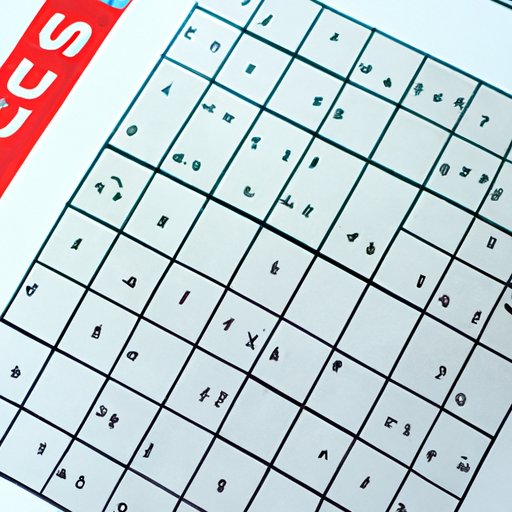
Introduction
If you’re looking for a fun and challenging brain workout, then Sudoku might be the perfect game for you. Sudoku is a logic-based puzzle game that involves filling in a 9×9 grid with numbers from 1 to 9. The game is popular all around the world, and for good reason – it’s a fun and addictive game that can help improve your mental agility and problem-solving skills.
In this article, we will walk you through the basics of how to play Sudoku, including step-by-step instructions for solving puzzles, helpful tips, video tutorials, printable puzzles, common mistakes to avoid, and the benefits of playing Sudoku.
Step-by-Step Guide
Before we dive into the step-by-step guide, it’s important to understand some of the basic terms and concepts used in Sudoku. The game is played on a 9×9 grid, which is divided into nine smaller regions, each containing three rows and three columns. The goal of the game is to fill in all the empty squares in the grid with numbers from 1 to 9. The catch is that each row, column, and region can only contain each number once.
Here’s a step-by-step guide to playing Sudoku:
- Look at the grid and identify any numbers that are already filled in.
- Start with an empty square and determine which numbers could potentially go in that square based on the numbers already in the row, column, and region that it belongs to.
- Use a pencil to write all the possible numbers that could go in that square.
- Repeat this process for every empty square on the grid until the grid is full.
It’s important to remember that you can always make changes to the numbers you’ve written in a square if you realize that they don’t work with the rest of the numbers on the grid.
Here’s an example Sudoku puzzle and its solution:

Tips and Tricks
While the basic rules of Sudoku are relatively simple, solving puzzles can be challenging. Here are some tips and tricks that can make the process easier:
- Use pencil notations. When you’re attempting to fill in a square, don’t be afraid to write down all the possible numbers that could go there. This can help you keep track of which numbers are still possibilities and which ones are ruled out.
- Use logical reasoning. When you’re trying to decide which number should go in a particular square, use logical reasoning to eliminate possibilities. For example, if there are already two 4s in a row, you can eliminate the possibility of a third 4 in that row.
- Use elimination techniques. If there is only one empty square in a particular row, column, or region, you can eliminate all the numbers that are already in that row, column, or region as possibilities for that square.
- Learn common strategies. Experienced Sudoku players often use specific techniques to solve puzzles efficiently, such as “hidden pairs,” “naked triplets,” and “swordfish.” It’s worth learning some of these techniques to become a better player.
Video Tutorial
Watching a video tutorial can be a great way to learn how to play Sudoku. In this tutorial, we will show you how to solve a puzzle step-by-step:
Watching a video tutorial can help you see how these various techniques work in real-time and can make the learning process more fun and interactive.
Printable Sudoku Puzzles
If you’re looking to practice your Sudoku skills, printable puzzles can be a great way to do so. Here are some printable Sudoku puzzles with varying difficulty levels:
- Easy: https://www.printablesudoku99.com/download/easy-sudoku
- Medium: https://www.printablesudoku99.com/download/medium-sudoku
- Hard: https://www.printablesudoku99.com/download/hard-sudoku
When using printable puzzles, it’s helpful to use a pencil to write down potential numbers in the empty squares and to erase them as you eliminate possibilities.
Common Mistakes
While solving Sudoku puzzles can be a great way to improve your mental agility, it’s easy to make mistakes as a beginner. Here are some common mistakes to watch out for and tips on how to avoid them:
- Not starting with the easiest squares. When you first look at a Sudoku puzzle, it can be tempting to start with the most challenging squares. However, it’s best to start with the squares that are easiest to solve, as they will help you build momentum and make the puzzle-solving process faster.
- Guessing randomly. It’s important to use logical reasoning and elimination techniques when attempting to fill in a square. Guessing randomly can make the process much more difficult and time-consuming.
- Not double-checking your work. It’s important to go back over the grid once you’ve finished to make sure that all the numbers are in the right places and that there aren’t any mistakes.
Benefits of Playing Sudoku
In addition to being a fun and challenging puzzle game, playing Sudoku can have several mental benefits. Scientific research has shown that playing Sudoku can improve memory, concentration, and problem-solving skills.
For example, a study conducted by the Alzheimer’s Association found that playing brain-boosting games like Sudoku can reduce the risk of developing dementia and cognitive decline.
Many people also report that playing Sudoku helps them feel more relaxed and less stressed, as it provides a mental break from the hustle and bustle of everyday life.
Conclusion
We hope that this article has provided you with a comprehensive guide to playing Sudoku. While mastering the game can take time and practice, the mental benefits and the satisfaction of solving a challenging puzzle make it all worthwhile.




